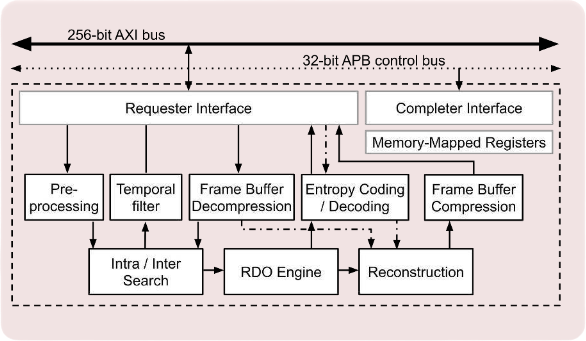Contents
- Compression Difficulty
- Reasons for VCU Development
- Video Encoder Core
- High-level Synthesis/Design Flow
- VCU ASIC and System
- Performance
- Software/Hardware Co-design
- References
Compression Difficulty
- Software Encoding Time relative to H.264:
- VP9: 10×
- H.264: 200×
- Software Encoding Time relative to H.264 1080p24:
- VP9 2160p60: 100×
- AV1 4320p60: 8000× [Why do they need 8K?]
Reasons for VCU Development
- Existing hardware encoders use 5× more bits for a given quality
- Desired features were unavailable:
- Full implementation of H.264 and VP9 encoding
- Single and Multi-Output Transcoding (SOT, MOT)
- Speed vs Quality Tuning
- Live Streaming & Offline Transcoding
- Full access to software control algorithms
- Reducing YouTube’s computing cycles dramatically
- Balance between quality, performance, flexibility, and cost
Video Encoder Core

Hardware Acceleration for video encoding
- H.264 2160p60
- VP9 2160p60
Interconnects:
- 256b AXI Bus
- APB Control Bus
Reads up to 4 frames and writes 1
Frame buffer compression to allow for greater scalability in the chip
Pre-Processing Engine
- Independent usage is possible
- Capabilities:
- Colour space conversion
- Cropping
- Scaling
- Rotation
Temporal Filter
- Alternate Frame Generation in VP9 encoding
- Separate operation (Prevents usage of other resources)
Motion-Search & Rate-Distortion Optimisation Engine
- Adjustable motion-search window
- Adjustable number of RDO candidates
- Allows for speed/quality trade-off
Reconstruction & Entropy Coding
- RD-Optimal Quantisation
- PSNR Calculation
- First Pass Statistics Collection
Registers
- Programmable registers allowing coding quality fine-tuning
- Controlled by software algorithms (such as Rate control)
High-level Synthesis/Design Flow
- In use for 10 years by codec team
- Designed VCU Core with Catapult (C++ HLS flow from Siemens)
- Instrumental in VCU development
- Enabled software/hardware co-design
- Allowed for very fast design iteration
Benefits of C++
- Separate algorithmic model is not required (Single source of truth)
- Bit-exact results between model and RTL
- 5-10× less code written, maintained and reviewed
- Able to use software development tools
- Address & memory sanitiser
- Distributed computing
- 7-8 orders of magnitude higher testing throughput
- 99% of functional bugs are found before simulation
Time for a Better Product
- Team can work on high-value problems
- Compiler can deal with cycle-for-cycle design
- No need to deal with block internal timing bugs
- Able to try a large number of algorithms and architectures
- Able to add features & improvements late in the process
- Trivial technology scaling
- Compiler can create a new data path for a new clock target and technology with the same C++ code
VCU ASIC and System
- Accelerators needed to address cost/performance gap caused by the end of Moore’s Law
- Designed for data centers
- Deployed only in clusters
- Heterogeneous clusters of CPU and VCU systems
- Maximises utilisation globally
- Diverse use-cases across many regions worldwide
- Support of fungible workloads
- Optimised for deployment at scale
- Toleration for chip and core level errors
- Reduced disruption from changes and failures
- Designed for agility and adaptability
- HLS
- Software control
- Use-cases and patterns vary
Chip Design Goals
- Maximum Utilisation
- Few jobs can use the full chip
- Isolated userspace queues
- Maximum userspace control
- Video rate control, quality and performance controlled with software
- Simple firmware work-items (DMA Data, run-on-core, etc.)
- Memory latency, average and peak bandwidth optimised to serve the cores
ASIC Layout

- Various components connected by NoC
- Microcontroller
- PCI Express
- DMA
- 3 Decoder Cores
- 10 Encoder Cores
- 4 LPDDR4 Controllers
- Microcontroller is attached to peripherals (Deal with low-speed I/O)
- 8 GB LPDDR4-3200 with ECC (6 LPDDR4 modules) [Weird ratio for ECC]
NoC Topology
- Supports bursty traffic and uniform access to memory for software simplicity
- 3 Interconnected Routers (~50 GB/s per Router)
- Microcontroller, PCIe, DMA, 3 Decoder Cores, 2 Encoder Cores
- 8 Encoder Cores
- 4 LPDDR4 Controllers (12 GB/s each)
- Router (8 GB/s) connecting PCIe egress to Microcontroller and DMA
Firmware
- Only controls work dispatch and isolation
- Userspace control of codec, parameters and dependencies
System
- Maximise VCUs per system to maximise performance/TCO$
- 20 VCUs per system
Performance

1 VCU matches a dual socket Skylake system in H.264 (Uses much lower power)
1 VCU matches five dual socket Skylake systems in VP9
20 VCUs replaces multiple racks of CPUs in VP9
Great performance scaling from 1 to 8 to 20 VCUs
- H.264: +5% (8×), +4.5% (20×) [Possibly limited by decoding]
- VP9: -0.5% (8×), -0.6% (20×)
Hardware decoding limits single-output transcoding performance
Multi-output transcoding speed is 1.2-1.3× single-output transcoding speed
Software/Hardware Co-design
- Tuning after deployment [Software capabilities are impressive]
- Quality improvement with parameter and software tuning (No firmware or driver updates)
- Opportunistic software decoding to reduce impact of limited hardware decoding
- Failure Management & Recovery
- Non-persistent Errors
- Software can retry after core errors
- Datacenter can retry after queue errors

